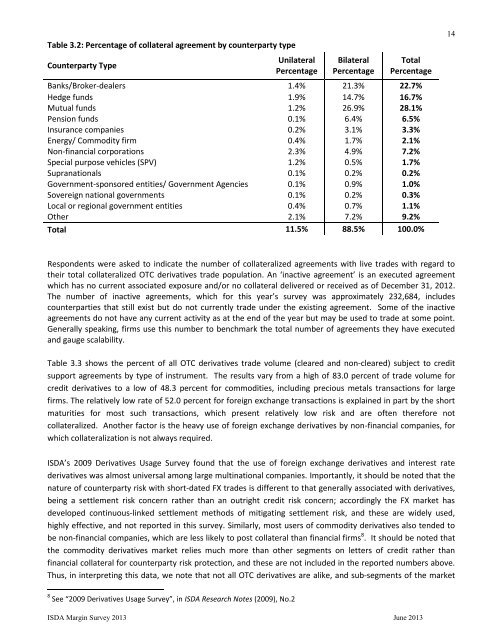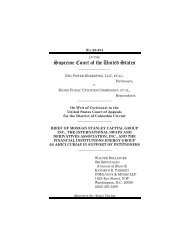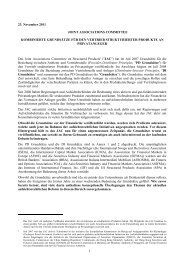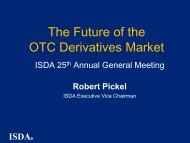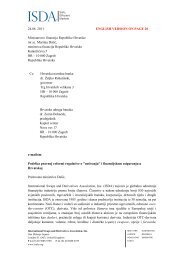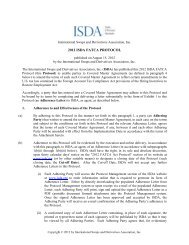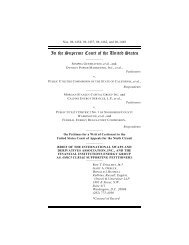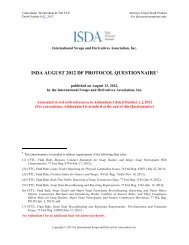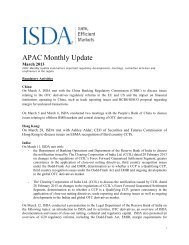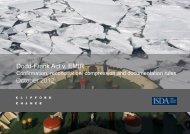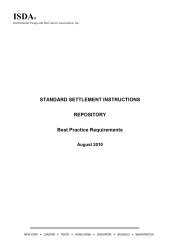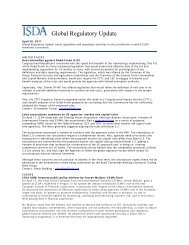ISDA Margin Survey 2013
ISDA Margin Survey 2013
ISDA Margin Survey 2013
You also want an ePaper? Increase the reach of your titles
YUMPU automatically turns print PDFs into web optimized ePapers that Google loves.
Table 3.2: Percentage of collateral agreement by counterparty type<br />
Counterparty Type<br />
Unilateral<br />
Percentage<br />
Bilateral<br />
Percentage<br />
Total<br />
Percentage<br />
Banks/Broker-dealers 1.4% 21.3% 22.7%<br />
Hedge funds 1.9% 14.7% 16.7%<br />
Mutual funds 1.2% 26.9% 28.1%<br />
Pension funds 0.1% 6.4% 6.5%<br />
Insurance companies 0.2% 3.1% 3.3%<br />
Energy/ Commodity firm 0.4% 1.7% 2.1%<br />
Non-financial corporations 2.3% 4.9% 7.2%<br />
Special purpose vehicles (SPV) 1.2% 0.5% 1.7%<br />
Supranationals 0.1% 0.2% 0.2%<br />
Government-sponsored entities/ Government Agencies 0.1% 0.9% 1.0%<br />
Sovereign national governments 0.1% 0.2% 0.3%<br />
Local or regional government entities 0.4% 0.7% 1.1%<br />
Other 2.1% 7.2% 9.2%<br />
Total 11.5% 88.5% 100.0%<br />
14<br />
Respondents were asked to indicate the number of collateralized agreements with live trades with regard to<br />
their total collateralized OTC derivatives trade population. An ‘inactive agreement’ is an executed agreement<br />
which has no current associated exposure and/or no collateral delivered or received as of December 31, 2012.<br />
The number of inactive agreements, which for this year’s survey was approximately 232,684, includes<br />
counterparties that still exist but do not currently trade under the existing agreement. Some of the inactive<br />
agreements do not have any current activity as at the end of the year but may be used to trade at some point.<br />
Generally speaking, firms use this number to benchmark the total number of agreements they have executed<br />
and gauge scalability.<br />
Table 3.3 shows the percent of all OTC derivatives trade volume (cleared and non-cleared) subject to credit<br />
support agreements by type of instrument. The results vary from a high of 83.0 percent of trade volume for<br />
credit derivatives to a low of 48.3 percent for commodities, including precious metals transactions for large<br />
firms. The relatively low rate of 52.0 percent for foreign exchange transactions is explained in part by the short<br />
maturities for most such transactions, which present relatively low risk and are often therefore not<br />
collateralized. Another factor is the heavy use of foreign exchange derivatives by non-financial companies, for<br />
which collateralization is not always required.<br />
<strong>ISDA</strong>’s 2009 Derivatives Usage <strong>Survey</strong> found that the use of foreign exchange derivatives and interest rate<br />
derivatives was almost universal among large multinational companies. Importantly, it should be noted that the<br />
nature of counterparty risk with short-dated FX trades is different to that generally associated with derivatives,<br />
being a settlement risk concern rather than an outright credit risk concern; accordingly the FX market has<br />
developed continuous-linked settlement methods of mitigating settlement risk, and these are widely used,<br />
highly effective, and not reported in this survey. Similarly, most users of commodity derivatives also tended to<br />
be non-financial companies, which are less likely to post collateral than financial firms 8 . It should be noted that<br />
the commodity derivatives market relies much more than other segments on letters of credit rather than<br />
financial collateral for counterparty risk protection, and these are not included in the reported numbers above.<br />
Thus, in interpreting this data, we note that not all OTC derivatives are alike, and sub-segments of the market<br />
8 See “2009 Derivatives Usage <strong>Survey</strong>”, in <strong>ISDA</strong> Research Notes (2009), No.2<br />
<strong>ISDA</strong> <strong>Margin</strong> <strong>Survey</strong> <strong>2013</strong> June <strong>2013</strong>


